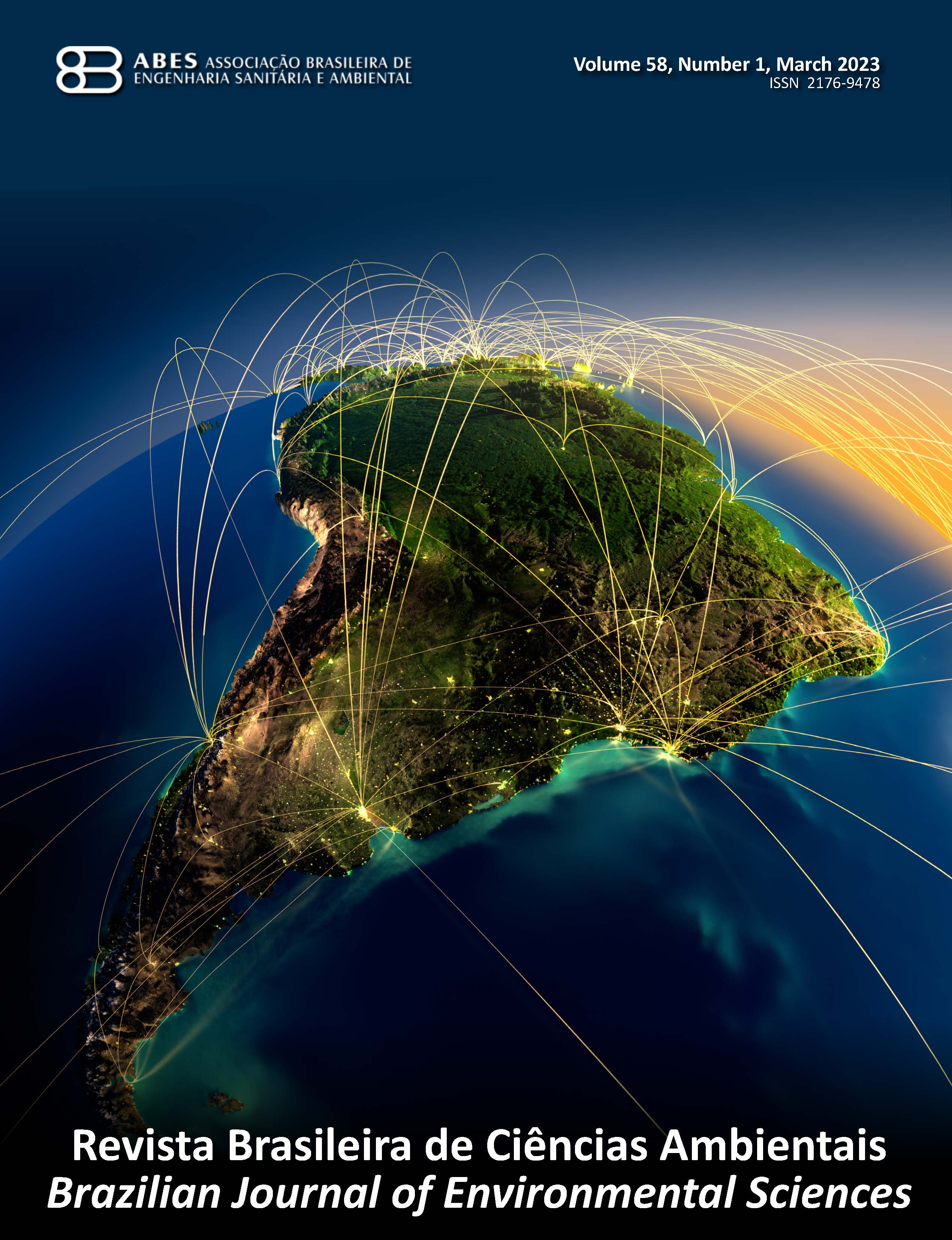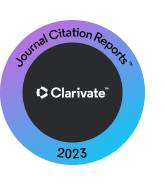Application of response surface methodology in the optimization of the clarification and filtration system for the treatment of water from Açude Grande (PB), Brazil
DOI:
https://doi.org/10.5327/Z2176-94782411Resumo
A deterioração da qualidade ambiental das águas do Açude Grande agravou a disponibilidade hídrica na cidade de Cajazeiras (estado da Paraíba, Brasil) em períodos de estiagem. Assim, o presente trabalho buscou avaliar a clarificação seguida de filtração para tratamento das águas do Açude Grande. A pesquisa é inovadora na aplicação de métodos de otimização em técnicas convencionais para o tratamento de mananciais considerados impróprios para o consumo humano, em localidades com recursos hídricos limitados e restrições econômicas e operacionais. Desse modo, as variáveis de concentração de sulfato de alumínio e pH foram otimizadas em função da remoção de turbidez e cor aparente na etapa de clarificação (coagulação, floculação e decantação), utilizando o planejamento fatorial do tipo delineamento composto central rotacional associado à metodologia de superfície de resposta. Posteriormente, a etapa de filtração, composta por uma camada de areia e brita, foi simulada em escala de bancada. Os resultados demonstraram que a dosagem do coagulante de 60,0 mg.L-1 e pH de 6 alcançaram a melhor remoção de turbidez (67,3%) e de cor aparente (78,1%), enquadrando o parâmetro turbidez nos limites da Portaria do Ministério da Saúde GM/MS n° 888/2021. Quanto ao processo de filtração, este apresentou uma boa eficiência na remoção dos parâmetros de turbidez (>77,0%), de cor aparente (>70,0%) e de demanda bioquímica de oxigênio (>46,0%) em comparação à amostra pós-clarificação. Conclui-se que o tratamento convencional tem potencial para adequar os parâmetros investigados aos padrões organolépticos de potabilidade, sendo sugerida a pré-oxidação para aumentar a remoção de matéria orgânica.
Downloads
Referências
American Public Health Association (APHA); American Water Works Association (AWWA); Water Environment Federation (WEF), 1992. Standard Methods for the Examination of Water and Wastewater. 18th ed. APHA, Washington, D.C.
American Public Health Association (APHA); American Water Works Association (AWWA); Water Environment Federation (WEF), 2017. Standard Methods for the Examination of Water and Wastewater. 23th ed. APHA, Washington, D.C.
Amiri, A.; Sabour, M.R., 2014. Multi-response optimization of Fenton process for applicability assessment in landfill leachate treatment. Waste Management, v. 34 (12), 2528-2536. https://doi.org/10.1016/j.wasman.2014.08.010.
Azzam, M.I.; Korayem, A.S.; Othman, S.A.; Mohammed, F.A., 2022. Assessment of some drinking water plants efficiency at El-Menofeya Governorate, Egypt. Environmental Nanotechnology, Monitoring & Management, v. 18, 100705. https://doi.org/10.1016/j.enmm.2022.100705.
Benakcha, M.; Masmoudi, T., 2024. Effect of adding biochar from prickly pear skin to aluminium sulphate to improve the coagulation-flocculation process during the elimination of humic substances present in the Laghrous drainage canal Water, Zab El-gharbi region (SE Algeria). Desalination and Water Treatment, v. 317, 100141. https://doi.org/10.1016/j.dwt.2024.100141.
Brasil, 2021. Ministério da Saúde – MS. Portaria n. 888, de 4 de maio de 2021. Diário Oficial da União, Brasília.
Brasil, 2023. Sistema Nacional de Informações sobre Saneamento. Diagnóstico temático serviços de água e esgoto: visão geral (Accessed March 25, 2024) at:. https://www.gov.br/cidades/pt-br/acesso-a-informacao/acoes-e-programas/saneamento/snis/produtos-do-snis/diagnosticos/DIAGNOSTICO_TEMATICO_VISAO_GERAL_AE_SNIS_2023.pdf.
Cañizares, P.; Jiménez, C.; Martínez, F.; Rodrigo, M.A.; Sáez, C., 2009. The pH as a key parameter in the choice between coagulation and electrocoagulation for the treatment of wastewaters. Journal of Hazardous Materials, v. 163 (1), 158-164. https://doi.org/10.1016/j.jhazmat.2008.06.073.
Chiavola, A.; Di Marcantonio, C.; D’Agostini, M.; Leoni, S.; Lazzazzara, M., 2023. A combined experimental-modeling approach for turbidity removal optimization in a coagulation flocculation unit of a drinking water treatment plant. Journal of Process Control, v. 130, 103068. https://doi.org/10.1016/j.jprocont.2023.103068.
El-Taweel, R.M.; Mohamed, N.; Alrefaey, K.A. Husien, S.; Abdel-Aziz, A.B.; Salim, A. I. Mostafa, N.G.; Said, L.A. Fahim, I.S.; Radwan, A.G., 2023. A review of coagulation explaining its definition, mechanism, coagulant types, and optimization models; RSM, and ANN. Current Research in Green and Sustainable Chemistry, v. 6, 100358. https://doi.org/10.1016/j.crgsc.2023.100358.
Ferreira Filho, S.S., 2017. Tratamento de água: concepção, projeto e operação de estações de tratamento. GEN/LTC, Rio de Janeiro, 463 p.
Fleyfel, L.M.; Matta, J.; Sayegh, N.F.; El Najjar, N.H., 2024. Olive mill wastewater treatment using coagulation/flocculation and filtration processes. Heliyon, v. 10 (22), e40348. https://doi.org/10.1016/j.heliyon.2024.e40348.
Husen, A.K.; Bidira, F.; Desta, W.H.; Asaithambi, P., 2024. COD, color, and turbidity reduction from surface water using natural coagulants: Investigation and optimization. Progress in Engineering Science, v. 1 (2-3), 100007. https://doi.org/10.1016/j.pes.2024.100007.
Kisakye, V., 2023. A bucket sand filter and Moringa Oleifera drinking water treatment hybrid system for rural households. Scientific African, v. 20, e01689. https://doi.org/10.1016/j.sciaf.2023.e01689.
Kolling Neto, A.; Ribeiro, R.B; Fraga, M.S.; Pruski, F.F., 2024. Estimating water balance in a Brazilian semiarid watershed using different spatial data. Journal of South American Earth Sciences, v. 140, 104930. https://doi.org/10.1016/j.jsames.2024.104930.
Myers, R.H.; Montgomery, D.C.; Anderson-Cook, C.M., 2016. Response Surface Methodology: Process and Product Optimization Using Designed Experiments. 4th ed. Wiley, Hoboken, New Jersey, 856 p.
Rachid, E.B.; Abderrahim, S.; Hafid, A.; Souad, R., 2024. Water treatment: aluminum sulfate, polymer, and activated carbon between efficacy and overdosing. Case of Oum Er-Rbia River, Morocco. Desalination and Water Treatment, v. 317, 100273. https://doi.org/10.1016/j.dwt.2024.100273.
Rodrigues, M.I.; Iemma, A.F., 2014. Planejamento de Experimentos e Otimização de Processos. 3th ed. Cárita Editora, Campinas, 358p.
Romphophak, P.; Chamnanmor, R.; Fagkaew, P.; Sairiam, S.; Painmanakul, P., 2024. Modelling the predictive analysis of turbidity removal efficiency in the in-line coagulation and flocculation process. Chemical Engineering Research and Design, v. 210, 301-310. https://doi.org/10.1016/j.cherd.2024.08.028.
Sabogal-Paz, L.C.; Campos, L.C.; Bogush, A.; Canales, M., 2020. Household slow sand filters in intermittent and continuous flows to treat water containing low mineral ion concentrations and Bisphenol A. Science of The Total Environment, v. 702, 135078. https://doi.org/10.1016/j.scitotenv.2019.135078.
Shah, A.; Arjunan, A.; Manning, G.; Batool, M.; Zakharova, J.; Hawkins, A.J.; Ajani, F.; Androulaki, I.; Thumma, A., 2024. Sequential novel use of Moringa oleifera Lam., biochar, and sand to remove turbidity, E. coli, and heavy metals from drinking water. Cleaner Water, v. 2, 100050. https://doi.org/10.1016/j.clwat.2024.100050.
Sória, M.; Tavares, V.E.Q.; Pinto, M.A.B.; Stumf, L.; Zarnott, D.; Bubolz, J.; Norenberg, B.G., 2020. Evaluation of physicochemical waterparameters in watersheds of southern Brazil. Revista Ambiente & Água, v. 15 (5), e2596. https://doi.org/10.4136/ambi-agua.2596.
Trinh, T.K.; Kang, L.S., 2011. Response surface methodological approach to optimize the coagulation–flocculation process in drinking water treatment. Chemical Engineering Research and Design, v. 89 (7), 1126-1135. https://doi.org/10.1016/j.cherd.2010.12.004.
Xiao, D.; Nan, J.; Zhang, X.; He, W.; Fan, Y.; Lin, X., 2024. Pilot-scale study of turbid particle evolutional/removal characteristics during coagulation-sedimentation-filtration (CSF): Effects of coagulant dosage and secondary dosing after breakage. Journal of Water Process Engineering, v. 68, 106325. https://doi.org/10.1016/j.jwpe.2024.106325.
Downloads
Publicado
Como Citar
Edição
Seção
Licença
Copyright (c) 2025 Revista Brasileira de Ciências Ambientais

Este trabalho está licenciado sob uma licença Creative Commons Attribution 4.0 International License.

























